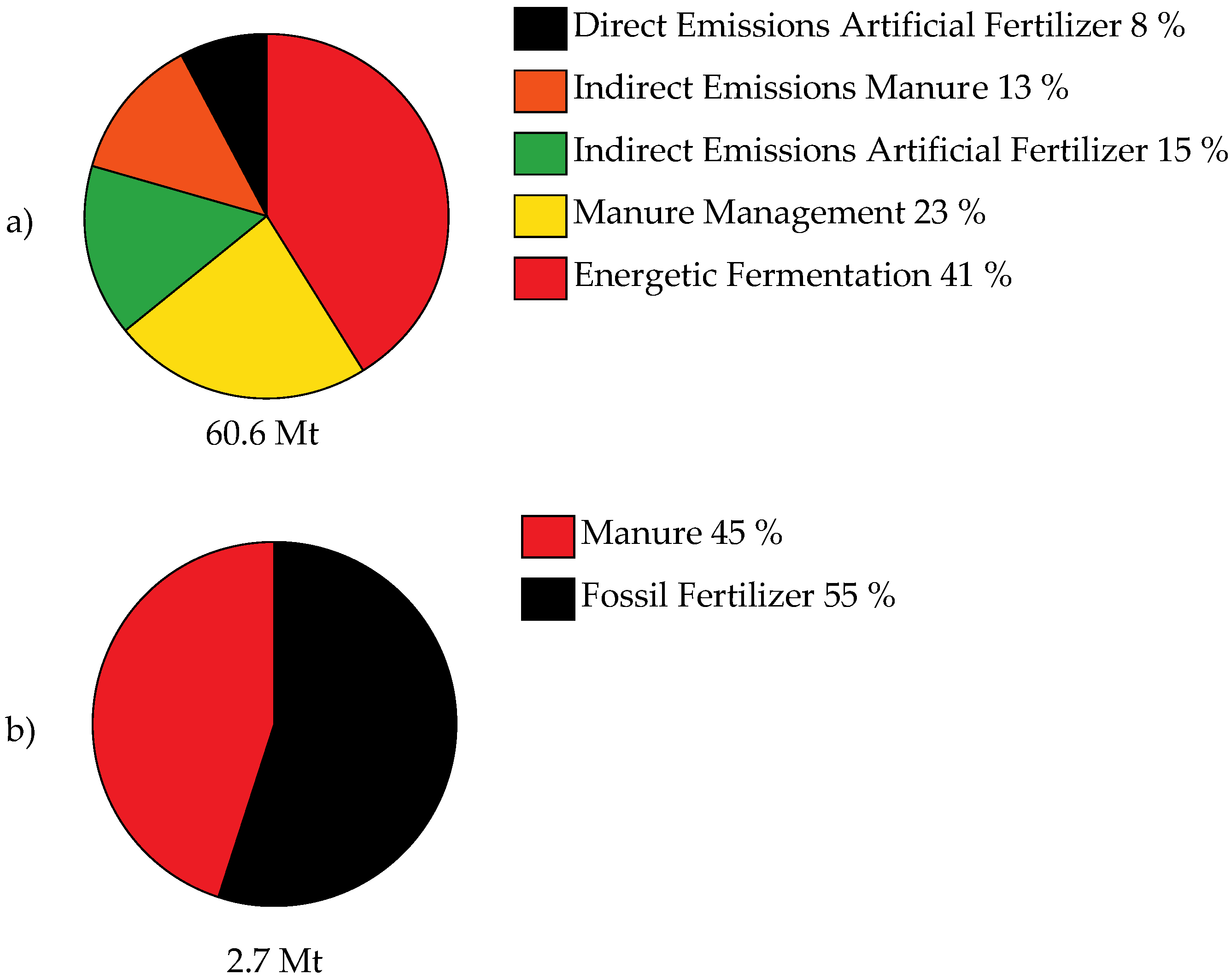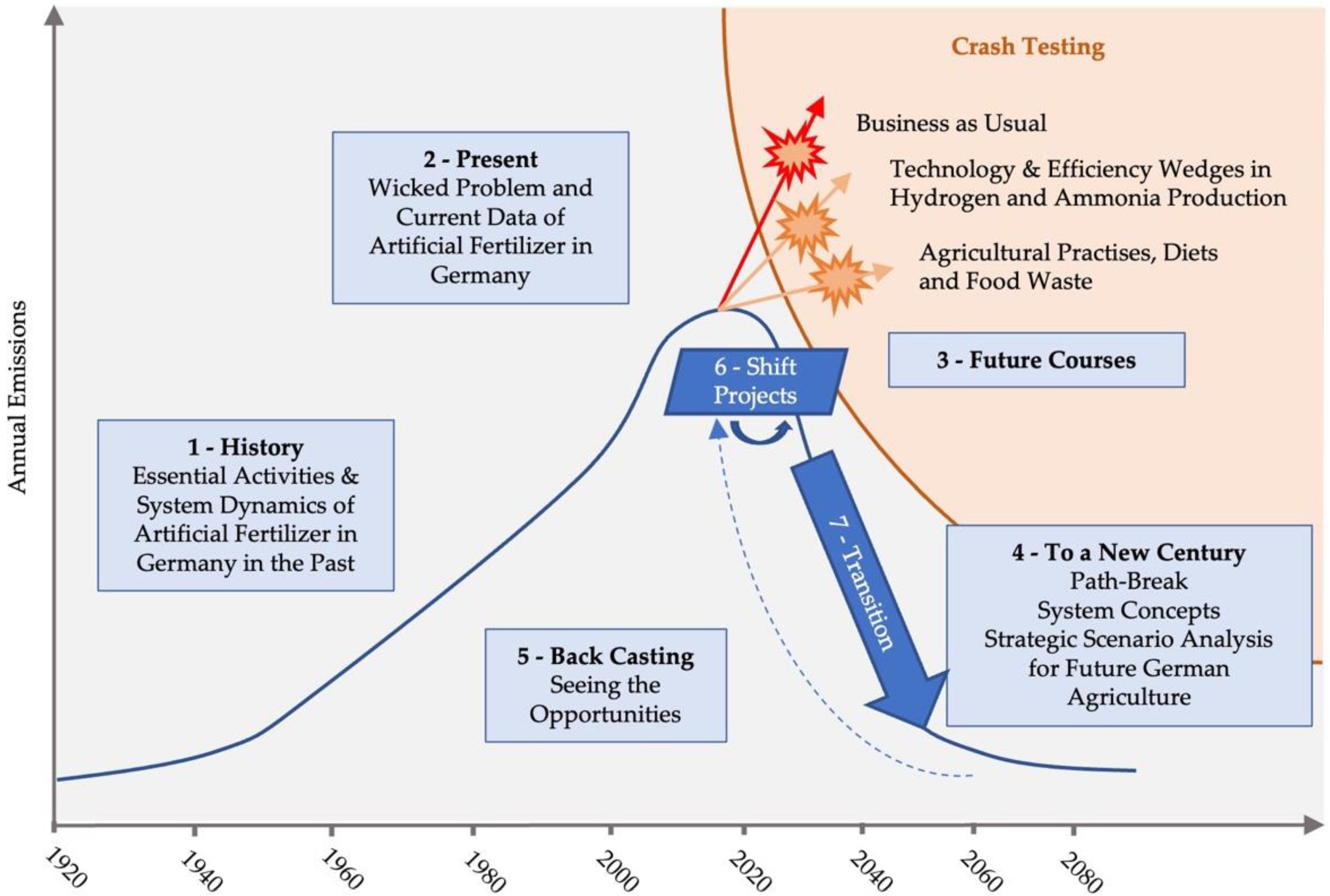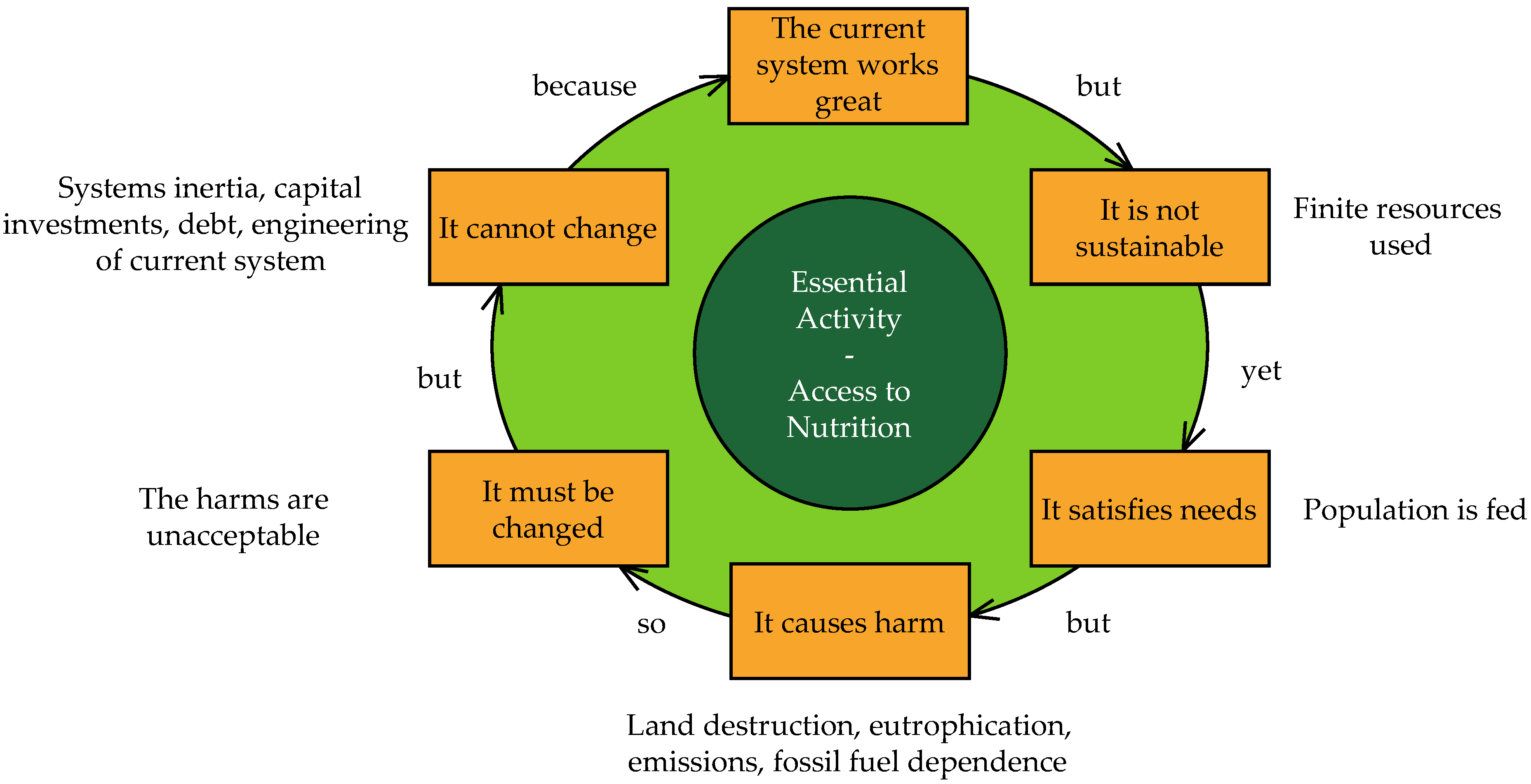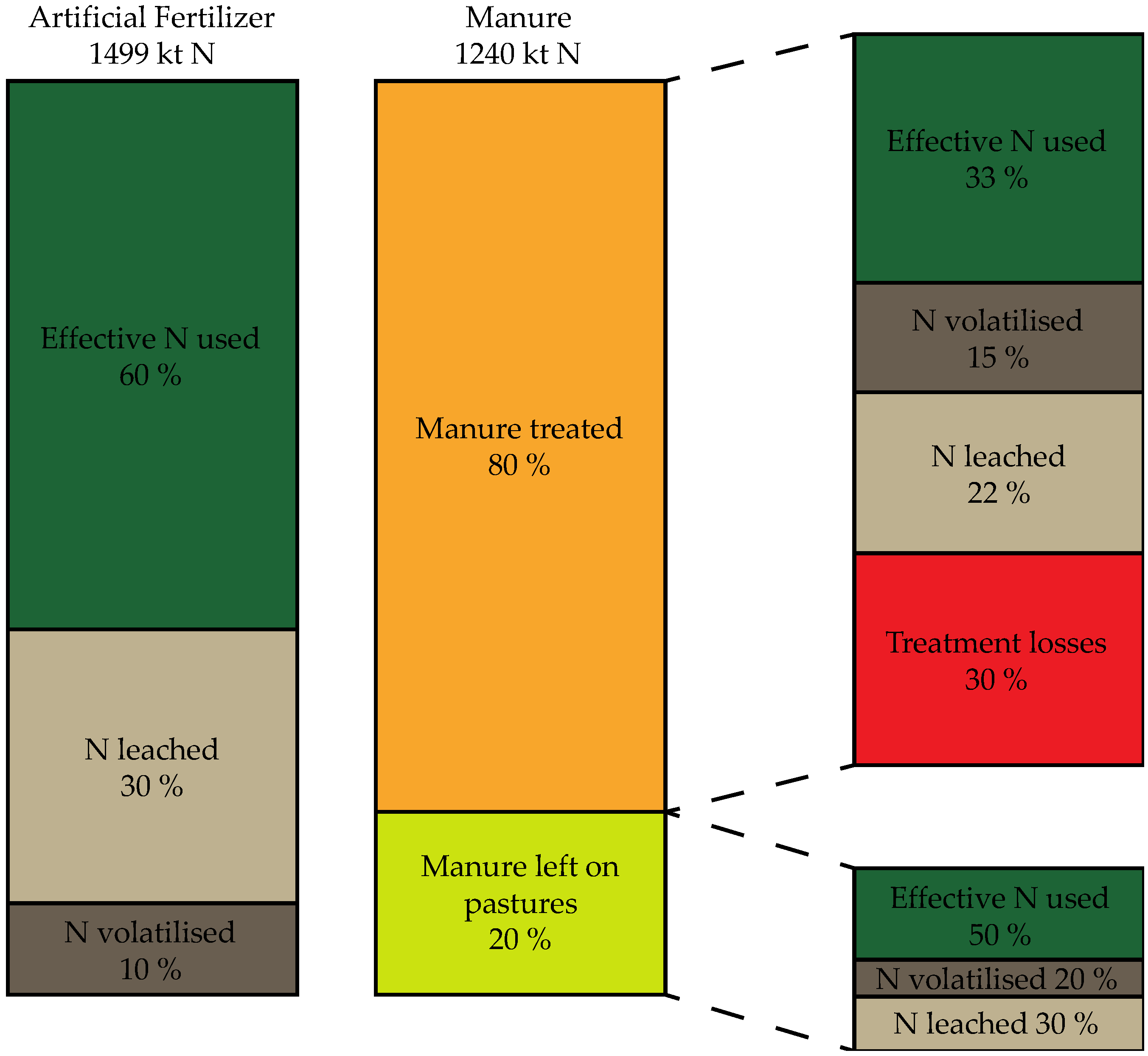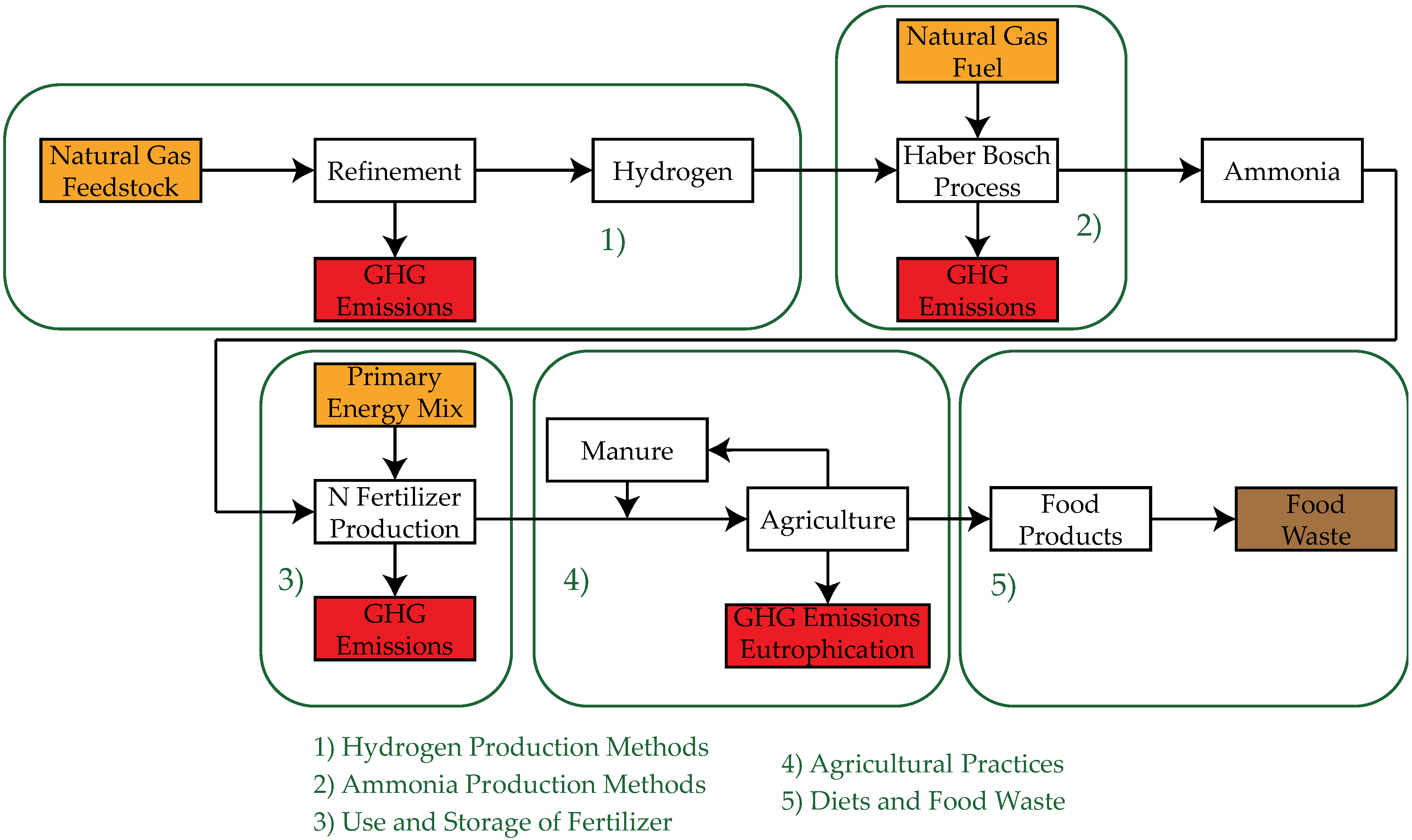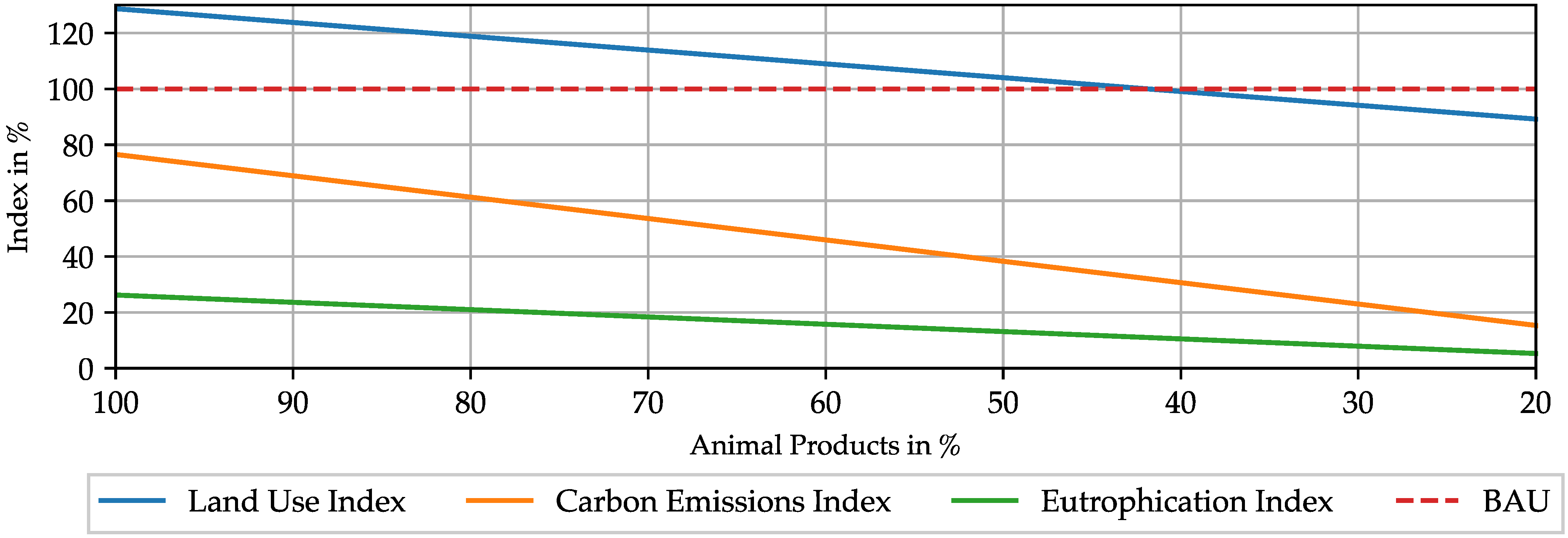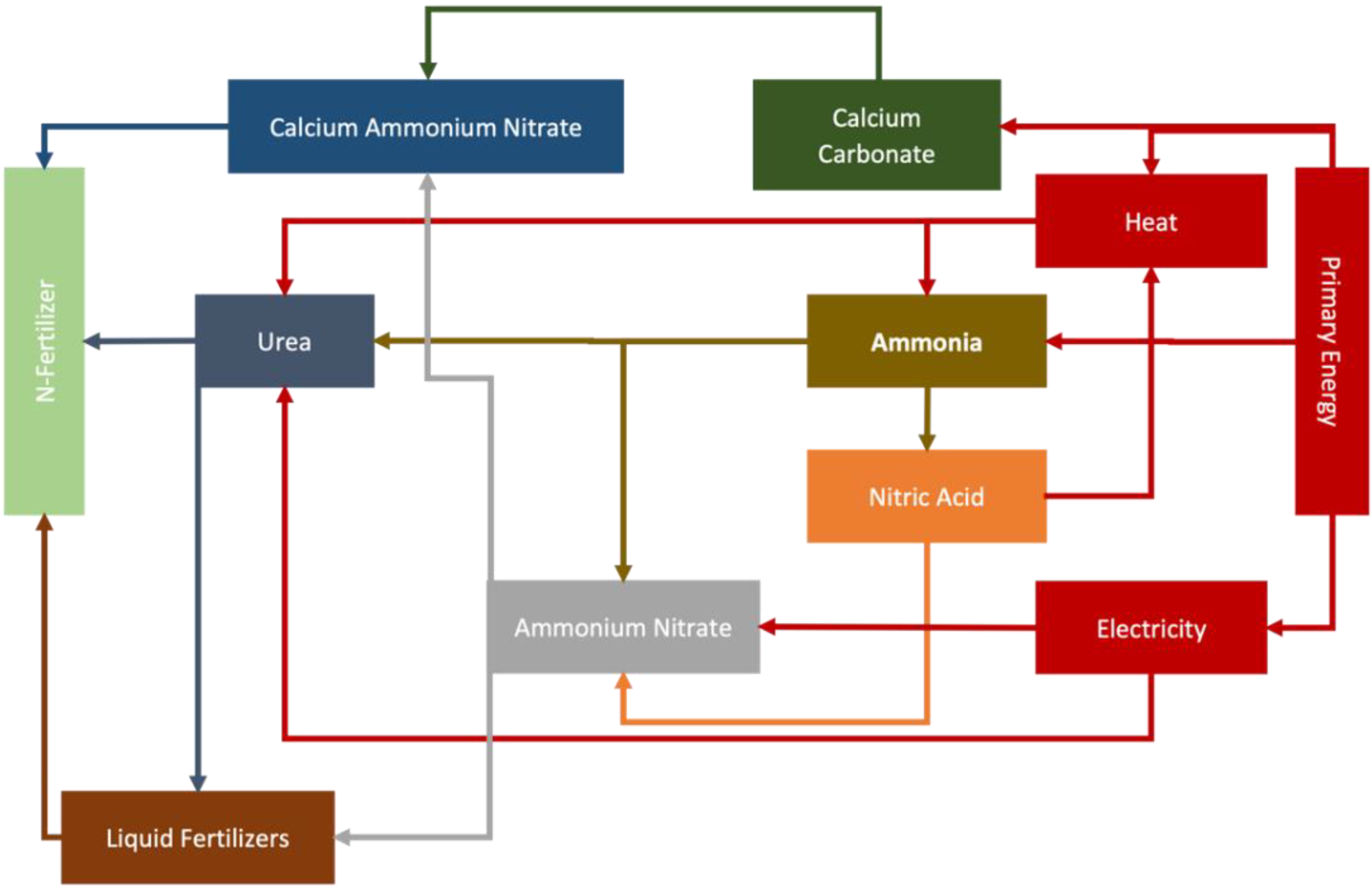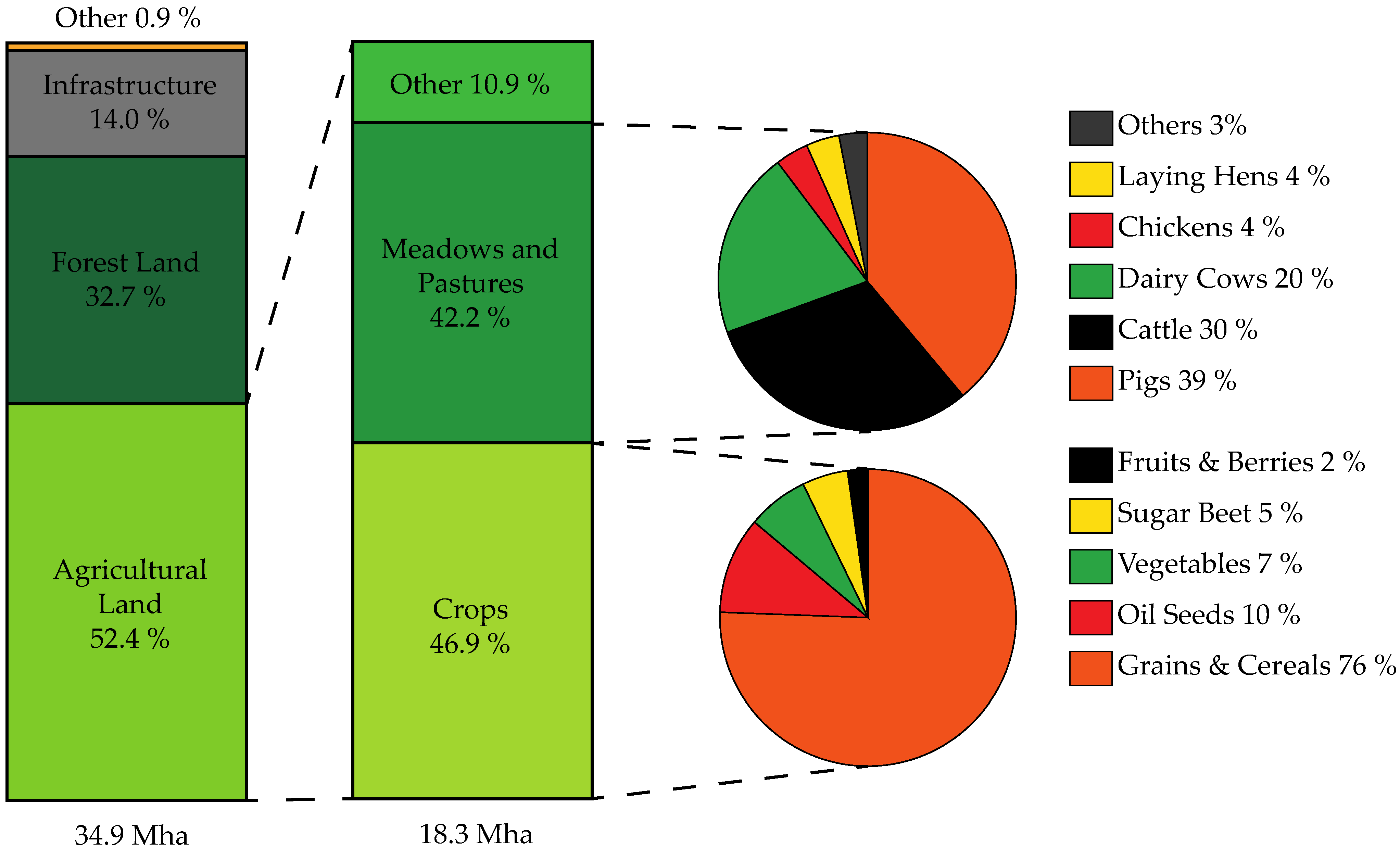This section works through the first three steps of the InTIME Method, taking a systemic perspective and relying on research of the literature and government sources. First, the metrics are set out for the analysis, then, different future scenarios to the business-as-usual (BAU) case in the literature are compared and possible, less unsustainable future courses identified.
The Fossil Fuel Use Index describes to the amount of fossil fuel used by a scenario related to the fossil-fuel use of the BAU case. The system boundaries include the fossil fuel needed to produce ammonia by fuel and feedstock.
The Energy Use Index analyses the ratio of energy used in a scenario to the energy use of the BAU case. Included energy expenditures account for the necessary primary energy to produce artificial-fertilizer and energy investments in new infrastructure.
The Mineral Depletion Index specifically aims to demonstrate the demanded new material mining for technology scenarios. It is assumed that Germany is assigned a share of the global mineral stocks in proportion of its GDP. Mineral extraction rates will be considered.
The Biodiversity Loss Index analyses the agricultural land use of a scenario in relation to the BAU. This includes the land use for growing crops as well as the land use dedicated to animal farming and meadows and pastures.
As for the Carbon Emission Index, here, the relation of carbon equivalent emissions of a scenario to the BAU carbon equivalent emissions are to be explored. The emissions of agricultural soils, fertilizer production, energetic fermentation of stockbreeding and manure management are considered.
The Eutrophication Index describes the ratio of leaching nitrogen in a scenario to the BAU case. The relative share of leaching nitrogen is assumed to be the same and the absolute values are compared. This metric deals with the overall fertilizer use of a scenario and the implied eutrophication issues.
3.1. Historical Development of Artificial Fertilizers in Germany
The historic evaluation of the role of nitrogen fertilizer in German agriculture aims to deliver an enhanced understanding of the evolution of the wicked problem over time. This evaluation begins with the non-industrialized agriculture of Europe in the 19th century and focusses on their nitrogen supply, agricultural practices, and dietary aspects.
At the beginning of the 19th century, three different ways of supplying agricultural land with nitrogen were in use: the application of manure and bone meal, the enrichment of manure with forest litter or hay and the cultivation of legumes in between crop rotation. The need for further fertilization raised with a growing population, an already close to maximum land use and increasing nutrient poverty in soils. Before the end of the 19th century, three different methods to produce mineral fertilizer were discovered. Coke oven gas (commonly used for lighting purposes) from the gasification of coal contained 0.7–1.5% ammonia in the form of ammonium nitrate with a nitrogen content of 21%. In South America, natural nitrogen sources occurred too. The extraction of sodium nitrate in the Atacama Desert in Chile showed a nitrogen content of 15–16% but was energy- and water-intensive in its production. Another source of nitrogen was the dung of sea birds from islands near Peru, which contained 14% nitrogen but the dung stocks were depleted in just 35 years [
40,
44,
45].
In 1895, Frank and Caro synthesized lime nitrogen from calcium carbide at 1000–1100 °C (later 700 °C) with nitrogen from air. In 1903, Birkeland and Eyde were able to synthesize nitric acid from nitrogen oxide and water. The nitrogen oxide was produced by an air stream through an electric arc at 3500 °C. Both processes were energy intensive and could only be maintained with cheap hydropower [
40]. In 1908, Haber patented his ammonia synthesis from nitrogen and hydrogen. It took 5 years for the first industrial ammonia reactor to be built with the help of Bosch [
40]. Since 1913, the production of synthetic nitrogen-based fertilizers has grown steadily. Nevertheless, the application of manure and bio-fixation accounted for the biggest intake of nitrogen in 1930, with a 20% share of synthetic nitrogen [
45].
Since the 1950s, the nitrogen input (fertilizer and fodder) to output (protein supply to humans) ratio has been generally positive and witnessed a rise from 1 to 3 in the 1980s. The overall protein intake rose between the 1950s and the 1980s, with a threefold rise in the share of animal-based protein intake [
46]. In 1960, natural gas replaced coal in the provision of hydrogen, following a massive saving in the energy consumption of the process and rising capacities. Those effects fuelled the rising share of artificial nitrogen fertilizers in Germany until the consumption peaked in the late 1980s. Since then, and with the fall of the Soviet Union, crop yields increased with the declining use of synthetic nitrogen-based fertilizers, due to a more efficient agriculture [
45].
In combination with a more efficient agriculture and the ever-rising application of synthetic nitrogen-based fertilizers, Germany was able to overcome self-sufficiency for beef, sugar, rye, and wheat in 1980. Between 1990 and 2016, a 20% emission reduction in the agricultural sector was achieved. This was due to less stockbreeding in east Germany after reunification and better fertilizer management in general [
10]. Today, the Haber–Bosch process makes up 80% of the world-wide industrial nitrogen production and uses four times less energy and land than in 1900 [
40,
44,
45].
The conclusion is that even past methods of fertilizing were not necessarily sustainable. Agriculture evolved along inefficient industrial ammonia production towards the well-engineered system of today. Cheap natural gas enabled the production of generally efficient mineral fertilizer and the over-fertilization of fields. There has been research to optimize the necessary nitrogen intake. Today, agriculture is the most efficient with less land, less energy, and less fuel use per nutrient output. Agriculture relies on the Haber–Bosch process. However, this system is still wasteful due to over-fertilization, diets, consumption, and food waste.
3.2. Current Data
Germany has a total land area of 35 Mha. As shown in
Figure 5, a third is covered by established or regenerating forest. Half of the country is used as agricultural land and the rest corresponds to man-made infrastructure including roads or buildings. Agricultural land can be divided in two main categories. Crop land covers 8.6 Mha or 46.9% of total agricultural land. Crop land has permanent uses, including fruit trees, and temporary uses, with crops harvested and sown on a yearly or less basis. Meadows and pastures occupy 7.7 Mha or 42.2% of total agricultural land. The number includes permanent and temporary pastures and grassland [
47]. A total of 76% of the crop land is dedicated to grains and cereals (maize, wheat, barley). Oilseeds (rapeseed, sunflower) cover up 10%. Vegetables (potatoes, peas, beans) cover 7%, of which half is dedicated to potatoes. Sugar beet uses 5% of the crop land. The remaining 2% is used by fruits, shrubs, and berries (apples, grapes, strawberries) [
48]. Fodder for farm animals takes up 57% of cereal production (around 25 million tons). A total of 10% of cereal production (4.5 Mt) is used as energy crops for bioethanol and biodiesel production. Only 20% (9 Mt) go to direct human consumption [
49]. One third or 12 Mt of the overall food production is wasted across the production chain [
50,
51]. A total of 56% of the cumulated food waste is avoidable, whereas households account for 40% of avoidable wastage [
51].
The animal stock head numbers are converted in livestock units (LSU) to allow comparison across animals. One LSU in Germany occupies 1.1 ha of agricultural land, on average [
52]. A total of 50% of meadows and pastures are dedicated to dairy cows and cattle. Pigs use 39% of that land. The remaining land is covered by chickens (4%), laying hens (4%) and other animals (3%), including turkeys, ducks, sheep, goats, etc. [
48]. From meadows and pastural land and considering the crop output going to farm animals, an estimated 11.4 Mha is dedicated to farm animals, which represents 62% of total agricultural land.
The agricultural sector produces 3559 kcal/capita/day with 105 g
Protein/capita/day, 149 g
Fat/capita/day and 448 g
Carbs/capita/day. Animal products (meat, dairy, and eggs) provide 1086 kcal/capita/day with 64 g
Protein/capita/day and 81 g
Fat/capita/day. Meat and animal fats provide half of the calories and protein [
53]. For reference, the British NHS recommends a daily calory intake of 2500 kcal/capita/day for men and 2000 kcal/capita/day for women depending on age, metabolism and levels of physical activity [
54].
Germany is self-sufficient for its potatoes, dairy products, meat, and cereal production [
49]. Other products require complementary importations. A detailed overview of the nutritional output of German agriculture is given in
Table A1.
3.3. Future Expectations, Policies and Technology Scenarios
In this section, the range of proposed policies, technologies, and actions proposed in scenarios in the scientific literature, in the Climate Action Plan of the German government, and in the European Farm-To-Fork policy are reviewed. The objectives are limitations of nitrogen losses in the process of fertilizer application, of harvest and post-harvest losses, and of over-all food waste. Measures for a reduction in nitrogen-fertilizers use to mitigate the associated harms are:
Limit losses in food production and food waste [
55,
56];
Limit over-production with focus on public health [
56];
Change in diet, specifically reducing meat [
7,
57,
58,
59];
Technical innovation, particularly renewable energy hydrogen [
33,
60];
Change in agricultural practice, including digital technologies [
61,
62,
63,
64];
Adequate pricing policy, including pricing on energy intensity, incentivising bio-physical values and costing of externalities [
58].
The scientific literature on German agriculture addresses the need for a change in policy to reduce harms, and critically examines misleading policy [
65,
66]. Two suggested changes in policies are the limitation of nitrogen surplus per hectare and higher prices for nitrogen fertilizer [
66]. Technical innovations have been proposed: chemical washing for the exhaust air of livestock breeding, substitution of urea with calcium ammonium nitrate, reduction in manure treatment losses and improved manure and artificial-fertilizer application [
66,
67]. It is suggested to recouple land use and livestock breeding, and to use low-protein pig food [
65,
67].
The agriculture component of the German Climate Action Plan for 2030 [
10] aims to reduce emissions by 15% below the 2017 benchmark, and sets the following objectives:
Furthermore, the Climate Action Plan sets the target for a nitrogen surplus reduction by 20% from 70 kgN/ha in 2021. The economic signal is to reduce emissions from ammonia production by making them subject to an emission trading scheme. Mainly technical measures are proposed: low-emission application techniques and fertilizer technology, gastight manure storage, research towards the interplay between NH3 and N2O from fertilizers, reduction in the energy demand of stationary and mobile agriculture technology and more renewable energies. An increase in organic agriculture from about 10% as of 2020 to 20% in 2030 is encouraged. Measures on the downshift of greenhouse gas emissions in stockbreeding are mentioned as well but are not sufficiently described in the Climate Action Plan for 2030.
The sustainability of agriculture is also well-represented on the European policy level in the Farm To Fork strategy [
28], with the common objectives being:
Reduction in fertilizer use;
Reduction in emissions from stockbreeding;
Increase in organic farming;
Shift in diets and consumption patterns;
Reduction in food waste
Similar to the German national targets, it is encouraged to generally reduce the use of fertilizer through improved nutrient management and precision agriculture. The emissions from stockbreeding are to be reduced through innovative feed additives. An increase in organic agriculture is incentivised through subsidies for sustainable farming practises under the Green Direct Payment policy [
68]. In addition to the German national targets, the importance of a dietary transition and a shift in consumption patterns are highlighted. This policy angle aims to fight obesity and over-consumption. It acknowledges the unsustainability and health overshoot of current energy, meat, sugar, fat, and salt consumption. Plant-based diets with a higher share of fruits, and less red and processed meat is encouraged.
A shift to organic agriculture has been considered to be more sustainable by the scientific literature and policy strategies. The general advantages in comparison to conventional agriculture are environmental friendliness, increased soil carbon levels, decreased soil erosion, higher energy efficiency, and lower fossil-fuel consumption [
63,
69]. Nevertheless, there are issues about organic agriculture in comparison to conventional agriculture that need to be addressed:
Smaller yields and less yield stability [
63,
70,
71];
Increased labour costs [
63,
72];
Secured supply of sufficient nutrients to a growing population [
63,
64,
69];
Decreasing yields due to decreasing nutrient availability while upscaling [
69];
Susceptibility to pest outbreaks, high weed pressure and changing N availability, which can lead to yield instability [
69].
The yields highly depend on crop rotation, weather conditions, and soil management practices [
63,
71]. Yields from organic agriculture outperform yields from conventional agriculture in droughts, because of improved water-holding capacity in the soil [
63,
69]. The overall costs are similar to conventional farming, while labour costs are increased [
63,
72]. If ecological externalities and the provision of ecosystem services are factored in, organic agriculture is more profitable than conventional agriculture [
63]. Organic livestock farms often require less labour per head, whereas general cropping can require from 29% less to 68% more labour per hectare depending on the country [
70]. Labour-intensity differences between organic and conventional farming also depend on farm size and structure [
70]. In general, organic agriculture alone will not be able to supply sufficient nutrition to a growing population with current diets and consumption patterns [
63,
64,
69]. Regarding the current interplay between organic and conventional farms, there is no clear evidence that organic farms are profiting from conventional pest control on nearby farms. Thereby, the high biodiversity in organic farming could benefit natural pest control [
69].
Crash Test of the Hydrogen for Fertilizer Scenario
The first examined scenario investigates the potential of implementing technological solutions to downshift greenhouse gas emissions [
73]. Substituting hydrogen from electrolysis of renewable electricity for natural gas in the artificial fertilizer manufacture is the most popular policy in Germany [
73]. For the crash-test analysis, the population, agricultural production, and land area were set at current levels. Since wind power is Germany’s largest renewable energy source [
74], new offshore wind farms and new energy-storage and conversion facilities are assumed to provide the electricity [
75,
76]. It is expected that the electrolyser is operated throughout the whole year and that the batteries compensate the necessary daily renewable energy fluctuation and secure supply security. The electricity from wind power is converted to hydrogen in a proton-exchange membrane (PEM)-type electrolyser. The PEM technology is more suited to ramping than technologies such as alkaline or solid oxide electrolysers [
77]. Li-Ion battery technology with a nickel–manganese–cobalt (NMC) cell chemistry was chosen with respect to applications in similar supply security projects [
78].
The rated power of the electrolyser is calculated from the yearly needed hydrogen output using typical offshore-wind utilization factors. The capacity of the battery storage system is derived from the daily energy that is needed to be supplied with respect to a limited depth of discharge and the mean round-trip efficiency. The lifetime of the capital plant is set to be the lifetime of the wind turbines and is assumed to be 20 years [
79]. The construction of new Haber–Bosch plants is not considered. The full explanation of modelling assumptions and references for the assumptions of this scenario are listed in
Table A2,
Table A3,
Table A4 and
Table A5.
The results show that 16.1 GWh/a of energy is required for the electrolysis. This translates into 6.12 GW of installed wind power, 3.06 GW of electrolysis capacity and 116.6 GWh battery capacity. The lifetime-levelized embodied energy in the capital equipment is 3132 TJ/a for wind turbines, 253 TJ/a for electrolysers and 233,223 TJ/a for batteries. The GHG emissions reduction compared to the methane-fed Haber–Bosch process is 4.6 MtCO2eq/a, whereas the added lifecycle emissions from the new capital equipment are 0.25 MtCO2eq/a for wind turbines, 0.04 MtCO2eq/a for electrolysers, and 0.94 MtCO2eq/a for batteries. The capital investments are EUR 25,713 million for the wind turbines, EUR 1041 million for the electrolysers, and EUR 58,307 million for the batteries. The most critical material, iridium, is required for the electrolysis with a total loading of 2.3 t. The batteries require a cobalt loading of 56 kt and graphite loading of 187 kt.
The hydrogen scenario reduces the natural-gas consumption for nitrogen fertilizer production to zero. The primary energy for the other production processes, as for ammonium nitrate, urea, calcium carbonate, and nitric acid, are not considered due to their relatively insignificant shares compared to the energy consumption of the ammonia production. The scenario has the same biodiversity loss and eutrophication as in the BAU current system, since no change in diet, fertilizer use, population size, or agricultural practice are assumed.
Results show that emissions increase to 102% for the hydrogen scenario over the BAU. The energy use index rises to 214% over the BAU scenario. The cost of the new infrastructure is more than one-hundred times (12,753%) that of today’s German agriculture GDP. The mineral depletion results are shown in years of production in
Table 1. Both iridium and cobalt need more than seven years of global production. It should be further noted that emissions from the production of ammonia are significantly lower than emissions from fertilizer application and meat and dairy animals.
The crash-test results show that the hydrogen scenario for fertilizer production is not feasible for immediate massive decarbonisation. The costs are high, and the scenario depletes precious materials and consumes more energy than the current system. Calculations are available in the
Supplementary Materials Excel Workbook.
